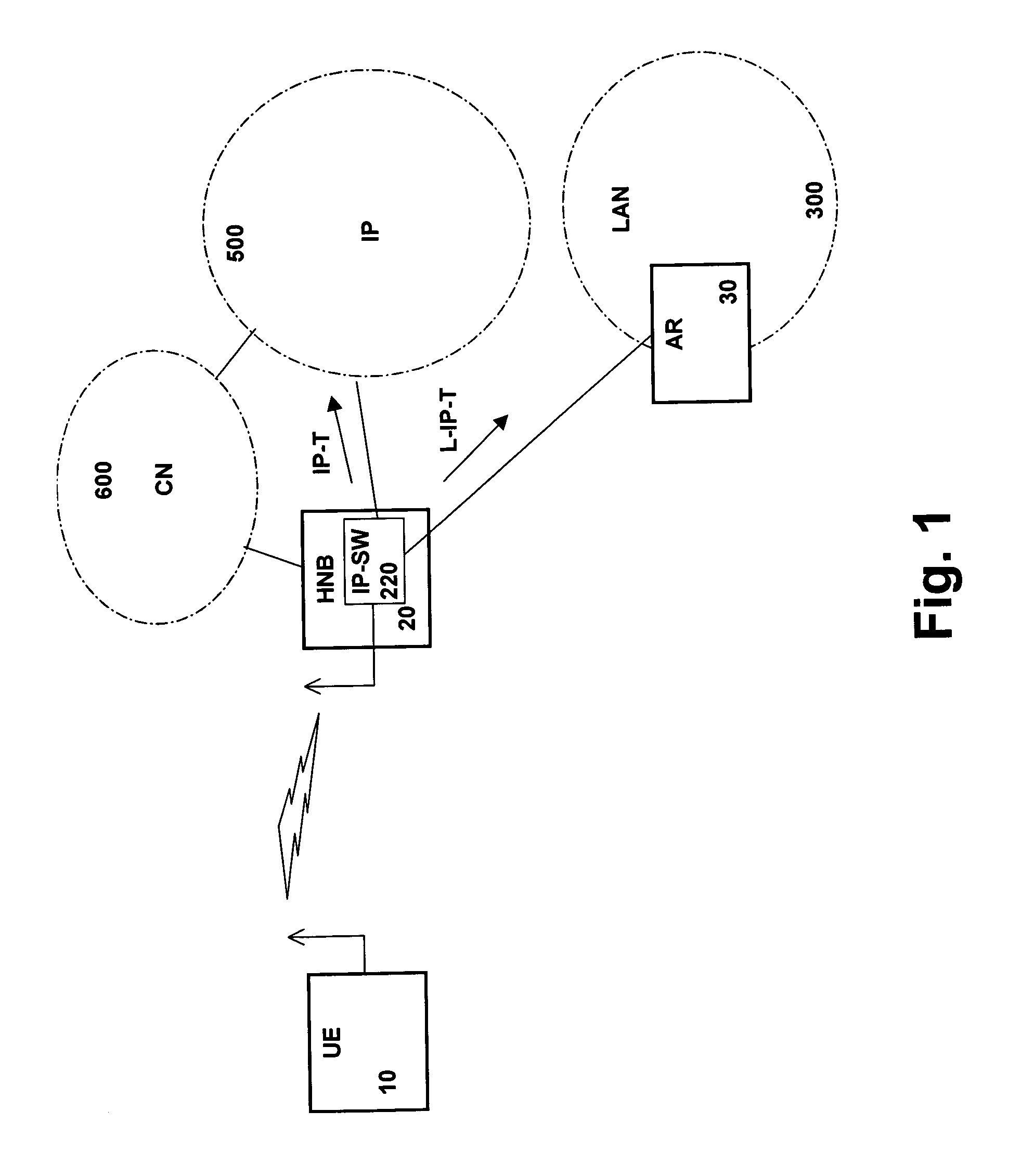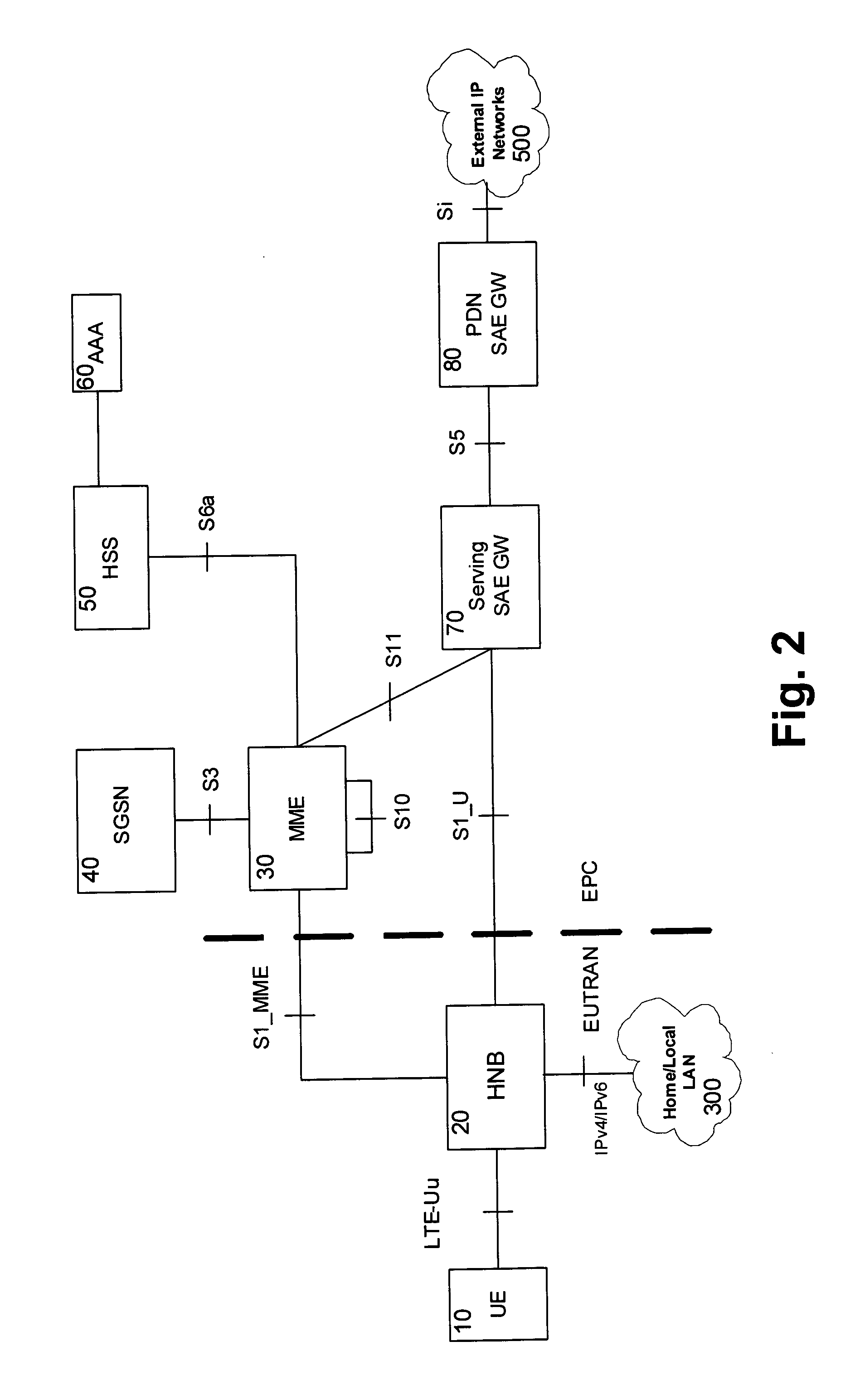Local breakout with parameter access service
a parameter access and local breakout technology, applied in the field of local breakout with parameter access service, can solve the problems of severe limitation, change of ggsn, increase of complexity and processing load, etc., and achieve the effect of less complex
- Summary
- Abstract
- Description
- Claims
- Application Information
AI Technical Summary
Benefits of technology
Problems solved by technology
Method used
Image
Examples
first embodiment
[0078]FIG. 3 shows a more detailed architecture of the network system with involved network elements according to a
[0079]In the first embodiment, the local IP access APN service function 75 has been placed in or at the same S-GW node 70 (or P-GW node) that provides the user plane mobility anchor point to the UE 10 in the EPC. In this way the requirement for a single S-GW per UE can be met, i.e., the UE specific S11 elementary procedures can terminate in the same endpoint both for the ordinary EPS bearer services and the local IP access services.
[0080]The S-GW 70 can trigger the selection of the local IP access APN service 75 based on the APN itself (e.g. special APNs for LBO), or the MME 30 may set certain individual or unique S11 message parameters for LBO specifically.
[0081]The pre-provisioned set of parameters in the local IP access APN service 75 can be common for all HNBs supporting local IP access service and also for those users having local IP access service subscription.
[00...
second embodiment
[0088]FIG. 5 shows a more detailed architecture of the network system with involved network elements according to a Here, a local IP access APN service 252 is placed into a HNB GW 25 which is used as an intermediated node to connect numerous HNBs to the EPC.
[0089]In this second embodiment also, the S-GW 70 does not need any modifications, as the standard S5 interface can be used between the S-GW 70 and the co-located local IP access APN service 252 in the HNB GW 25.
[0090]In case LBO shall be supported optionally at the HNB GW level, then a co-located P-GW function 251 could be implemented there and controlled over the same S5 interface as the local IP access APN service 252 supporting LBO directly from HNB 20. In the MME 30 the standard P-GW selection procedure can be used and the HNB-GW address can be derived from the LBO-APN.
[0091]The local IP access APN service 252 and the P-GW function 251 in the HNB GW 25 could be implemented either as co-located functions (integrated into HNB...
third embodiment
[0092]FIG. 6 shows a more detailed architecture of the network system with involved network elements according to a Here, a local IP access APN service 254 is placed into the HNB 20 itself.
[0093]Thus, the S5 control-plane interface termination in the HNB 20 from the S-GW 70 provides a less inferior solution for local IP access or LBO. The Stream Control Transmission Protocol (SCTP) based S1_MME interface can be kept as the only control-plane interface between the HNB 20 and the MME 30 (physically separate nodes), so that the MME 30 can be kept as it is.
[0094]Furthermore, the S1-U and the S5 interfaces are GTP based interfaces and terminate in the same physical S-GW 70. This enables combination of these two interfaces based on the fact that the GTP protocol supports both user and control plane handling.
[0095]Only “PDN GW like” local gateway function is required in the HNB 20 for assisting with the protocol configuration option (PCO) parameters to be passed via the MME 30 (e.g. param...
PUM
 Login to View More
Login to View More Abstract
Description
Claims
Application Information
 Login to View More
Login to View More - R&D
- Intellectual Property
- Life Sciences
- Materials
- Tech Scout
- Unparalleled Data Quality
- Higher Quality Content
- 60% Fewer Hallucinations
Browse by: Latest US Patents, China's latest patents, Technical Efficacy Thesaurus, Application Domain, Technology Topic, Popular Technical Reports.
© 2025 PatSnap. All rights reserved.Legal|Privacy policy|Modern Slavery Act Transparency Statement|Sitemap|About US| Contact US: help@patsnap.com



